| 1868: |
December 29, Elko founded by the Central Pacific Railroad (later Southern
Pacific, now Union Pacific).
Townsite laid out.
|
| 1869 |
Railroad agents sold lots for $300 to $500 each.
Early in the year the town was made up of about sixty tents.
|
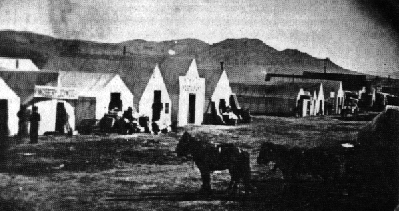
Earliest existing photograph of Elko. Taken in 1869. Courtesy of
Northeastern Nevada Museum.
|
|
March 5, Elko County formed and Elko named the county seat.
A brick courthouse is constructed at Sixth and Idaho streets at a cost
of $20,000.
| 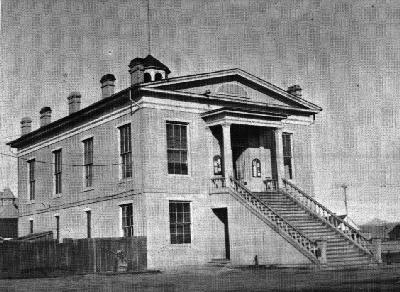
First Elko County Courthouse, built on the northwest corner of
Sixth and Idaho in 1869. It was in use until torn down and
replaced by the present structure in 1910. Original cost of this
building was $20,000. Photo: Northeastern Nevad Museum.
|
|
Humboldt Lodging House (predecessor of the Commercial Hotel) built.
Elko's first newspaper, the Elko Independent, begins publication on
June 19.
Cosmopolitan Hotel built next to the railroad track, 80 rooms.
Missouri Flats, in the vicinity of Silver and Ninth streets, is headquarters
for freighters, their animals and rigs.
An opera house in a tent opened. Culture arrived early.
Pioneer Saloon began business on the northeast corner of Fifth and Railroad.
A resort, White Sulphur Hot Springs, was built near the Hot Hole off
Bullion Road.
Elko's 45 saloons outnumbered all other businesses in town.
|
| 1870: |
The first church was the Presbyterian, built at Sixth and Pine.
First school opened at 421 Court with 70 students, cost was $3,000.
(Site of Chilton Engineering, different building).
|

First school building was built at 421 Court Street in 1870. It
opened with 70 students and enrollment doubled to 140 by the end
of the first year. After a new school was constructed five blocks
east, the building was used as a Knights of Phythias Hall. A new
KP hall was later built on the same site and is presently owned
by Chilton Engineering. Photo: Northeastern Nevada Museum.
|
|
Lots now selling from $1,500 to $2,000.
Population estimated at 4,500.
|
| 1871: |
Fire destroys most of the business district.
Elko cattleman, Lewis "Broadhorns" Bradley elected second governor of
Nevada.
|
| 1872: |
A brickworks at Idaho and the road to Mountain City begins business.
|
| 1873: |
1873: Cosmopolitan renamed the Chamberlain (later changed to Depot
Hotel). |
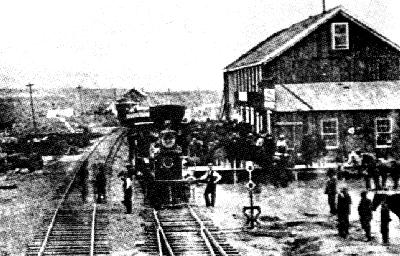
Early 1869 photo of Elko showing the Depot Hotel. The lodging place has 80 rooms, a dining room that seated 112, a billard room, bar and barbershop. Photo: Northeastern Nevada Museum.
|
| 1874: |
Elko is selected the first site of the University of Nevada. A building
is constructed on the northeast corner of College Avenue and Ninth. (Where
the "old gym" at the high school presently stands).
Population estimated at 5,000.
|
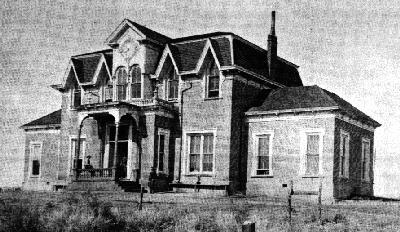
First University of Nevada building. Located at the corner of
Ninth and College streets. Now you now where College Streets got
its name. After the university was moved to Reno in 1885. The
building was the county hospital for many years. It was torn down
in 1928.
|
| 1875: |
Elko Flour Mill, Commercial between Seventh and Eighth, begins operation
and provides the first water system for the town.
University of Nevada dormitory built on Ninth and Court. (Still there).
|
| 1877: |
October 7, two-story brick school building opens on the north side
of Court between Eighth and Ninth.
|
| 1882: |
White Sulphur Springs Hotel burns down, rebuilt.
Population estimate is 600. Area mining curtailed causing a Nevada-wide
depression.
|
| 1883: |
Elko Free Press begins publication on January 5.
|
| 1885: |
University of Nevada moved to Reno.
Population estimated at 1,000.
|
| 1886: |
Elko Flour Mill generates first electricity and supplies power to a
few street lights.
|
| 1892: |
Episcopal Church dedicated at Fifth and Idaho.
|
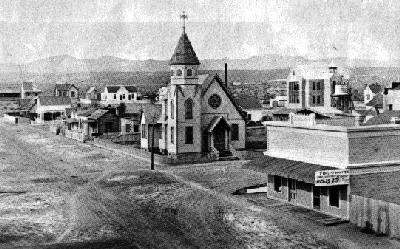
Fifth and Idaho Streets in 1896. The Episcopal Church is now the site of the Esquire Motor Lodge. A cafe, advertising meals for 25 cents, is where Algerio Real Estate is now located. Photo: Northeastern Nevada Museum.
|
| 1896: |
Elko County High School, the first county school in the state, opens
on Court and Sixth with 43 students, cost is $7,420. It is a two-story
building used until the present high school buildings were constructed
on College. The building, without its second story, still stands behind
the present courthouse and is used for county offices.
|
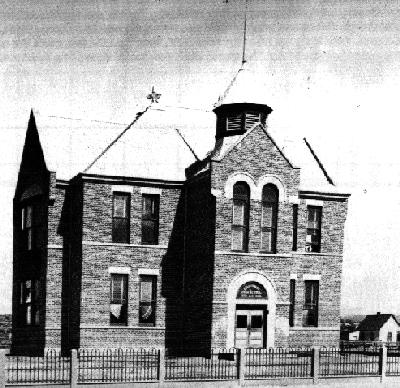
First county high school in the state at Court and Sixth streets.
Opened in 1896, the operated until the new campus was built in
1918. The building, without its second floor which burned in
1942, is now used for county offices. Photo: Northeastern Nevada
Museum.
|
| 1899: |
Hot Springs hotel burns again, rebuilt again.
|
|
| 1904: |
Depot Hotel is demolished and the Mayer Hotel (present site of the
Stockmen's Hotel) constructed.
Population estimated at 800.
|
| 1907: |
Chamber of Commerce formed.
|
| 1908: |
Western Pacific Railroad (now Union Pacific) lays track through town
and builds a depot. WPRR tracks ran on Silver and Southern Pacific rails
ran between Railroad and Commercial. (Present downtown parking area). Both
sets of tracks relocated south to their present locations in 1984.
|
| 1910: |
New courthouse built on northwest corner of Idaho at Sixth (same site
as first courthouse), cost $150,000.
New grammar school replaces older facility on Court between Eighth and
Ninth.
|
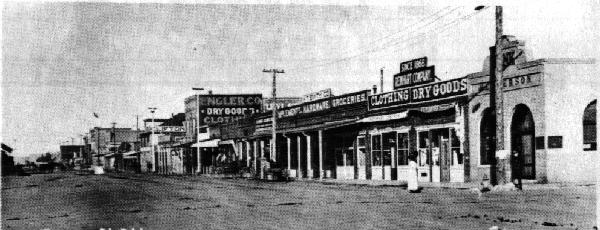
Commercial Street in 1910 looking east. Photo: Northeastern
Nevada Museum.
|
| 1913: |
Elko-Lamoille Power Company provides direct electric current to Elko.
Nevada Industrial School (boys reformatory) opens four miles east of
town. Now the Nevada Youth Training Center.
Pioneer Hotel building completed. ( Now the Western Folklife Center.)
|
| 1915: |
Elko-Lamoille Power Company switches to alternating current.
|
| 1916: |
Catlin Shale Products Company opens an experimental oil extraction
plant southwest of town off Bullion Road. Operated until 1925. Extraction
methods developed there are still in use today.
Population estimated at 2,500.
|
| 1917: |
Elko incorporated as a city.
J.A. McBride is first mayor.
Elko Municipal Water Works established.
|
| 1918: |
Grammar school on Court burns down on Christmas Day.
|

Christmas Day, 1918. The building had been used for only eight
years. Freshly oiled floors were blamed. Photo: Northeastern
Nevada Museum.
|
| 1919: |
New elementary school built on same site. The school is called Number
One until it was renamed to honor Kate St. Claire in 1973. Nevada's first
community college was also housed in the building until it was demolished
in 1974 to make way for the Green Acre apartments.
|
| 1920: |
Elko designated an airmail station on the first transcontinental route.
First county fair held on the Garcia rodeo grounds located south of
the river.
|
| 1921: |
Elko General Hospital built at the corner of College and Thirteenth.
|
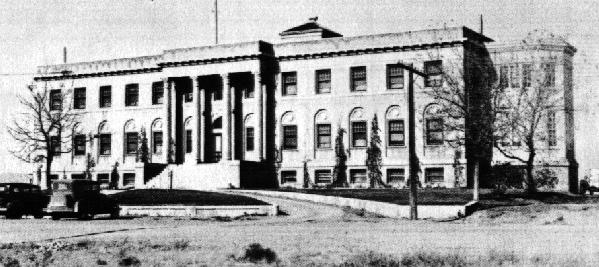
Elko General Hospital at College and Thirteenth around 1940.
Built in 1921, it was in use until demolished in 1978 for the
present building immediately west of the old structure. Photo:
Northeastern Nevada Museum.
|
|
| 1926: |
Elko becomes the terminus of the first commercial airmail flight in
the nation when Varney Airlines (later part of United Air Lines) completes
flight from Pasco, Washington.
County library moved from courthouse to the second floor of the old
high school building at Court and Sixth.
|
| 1927: |
Present County Fairgrounds built on part of old China Ranch were Chinese
once raised vegetables for sale in town.
|
| 1929: |
Henderson Bank Building, tallest in town, opens.
|
| 1930: |
Elko Flour Mill torn down.
First Elko High School Band formed.
|
| 1932: |
Gambling legalized.
|
| 1933: |
Present downtown Post Office Building opens.
|
| 1934: |
Elko attorney Morley Griswold becomes 16th governor of Nevada when
Fred Balzar dies in office.
First street paving program begins.
|
| 1939: |
Elko attorney Edward Carville becomes 18th governor. Later appointed
U.S. Senator.
|
| 1941: |
Big name entertainment begins in Nevada in The Lounge of Elko's Commercial
Hotel with Ted Lewis and his orchestra.
|
| 1942: |
1942: Fire destroys second floor of the old high school building. The
burned part is removed and the first level is remodeled to be the home
of the Elko County Library until the new library building was built
at Court and Seventh in 1974.
|
| 1944: |
Mayer Hotel becomes Stockmen's Hotel.
On December 8, Marilyn Patterson christens the military transport ship,
S.S. Elko Victory.
|
| 1946: |
Ranchinn opens with 68 rooms on Idaho between Eighth and Ninth.
|
| 1947: |
DeLuxe Cleaners building at 511 Railroad collapses killing three.
|
| 1948: |
City Hall at 723 Railroad opens, remains as city hall until the new
one was built in 1972 at 1751 College.
Famous movie star and crooner Bing Crosby is named "Honorary Mayor of
Elko." He held the post until his death in 1977.
Elko's first radio station, KELK, begins broadcasting.
|
| 1951: |
Former Elkoan, Charles B. Russell, becomes Nevada's 20th governor.
World premiere of movie, "Here Comes the Groom," starring Bing Crosby
held at the Hunter Theater in Elko.
|
| 1956: |
1956: Northeastern Nevada Historical Society formed.
|
| 1957: |
Stockmen's Hotel burns, new hotel and casino built on the same site.
|
| 1959: |
Grant Sawyer, an Elko attorney, is Nevada's 21st governor.
|
| 1966: |
New high school gymnasium at Cedar and Ninth built.
|
| 1967: |
Elko citizens group forms first community college in the state. It
is quartered in Number One school until its new campus is constructed at
901 Elm Street. First named Elko Community College, then Northern Nevada
Community College, today it is Great Basin College.
|
| 1968: |
Northeastern Nevada Museum, 1515 Idaho Street opened in a small white
brick building. New construction and remodeling was completed in 1982,
and 1998 will see the debut of the new wing. The museum has won numerous
awards, including the highest, the American Association for State and Local
History Award of Merit (twice).
|
| In the next 20 years to 1998, Elko underwent changes that
have forever altered its personality and looks. The growth came mainly
from nearby gold mines that made northeast Nevada the largest gold producing
area in the nation. With the discovery of microscopic gold and new methods
of extraction came people from all over the world and Elko's population
exploded.
Elko today is the largest community between Salt Lake City (235 miles
to the east) and Reno (290 miles west). The community's remoteness gives
the people a certain spirit of independence and it remains as one of the
American West's premier frontier towns. Yet, there is a special metropolitan
spirit because it is the social and cultural center for an area larger
than most states back east.
Times have changed but the place is still a 24-hour town where the casinos
never close. Some say that Elko is an evil place in which to live with
its legalized gambling, drinking, and other vices, but the town has solid
citizens with a strong economy, excellent schools, Great Basin College,
Western Folklife Center, churches, the Northeastern Nevada Museum, Convention
Center, and many cultural activities lacking in other cities of the same
size.
It is a pleasant place to live with clean air, numerous cultural events,
the spectacular nearby Ruby Mountains, people who still have time to stop
and chat for a few minutes, boundless outdoor and sports activities, ghost
towns where one can walk a few moments in the past...the list is long and
it is up to you to decide what you want to do it. Take some time to enjoy
the people and the land. |









